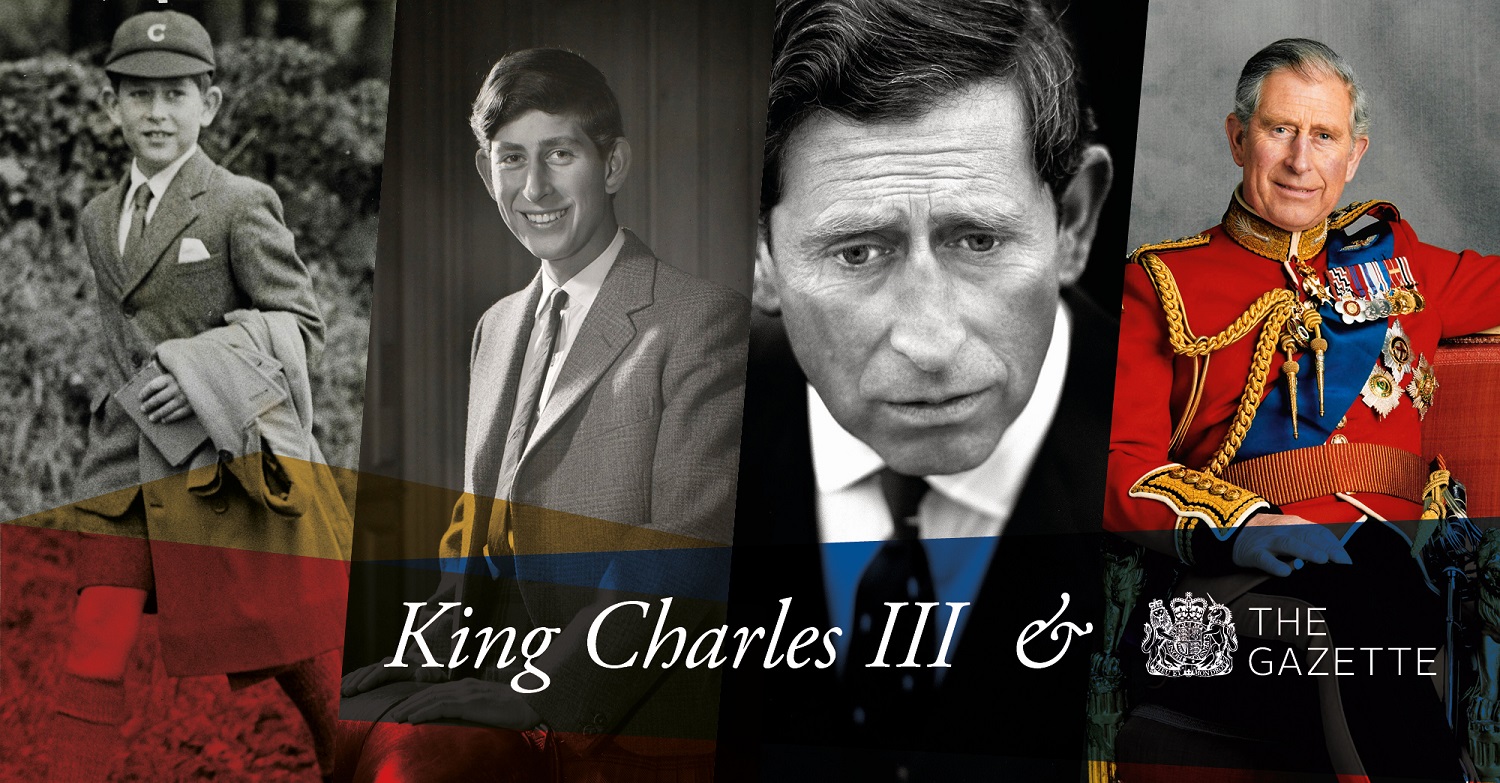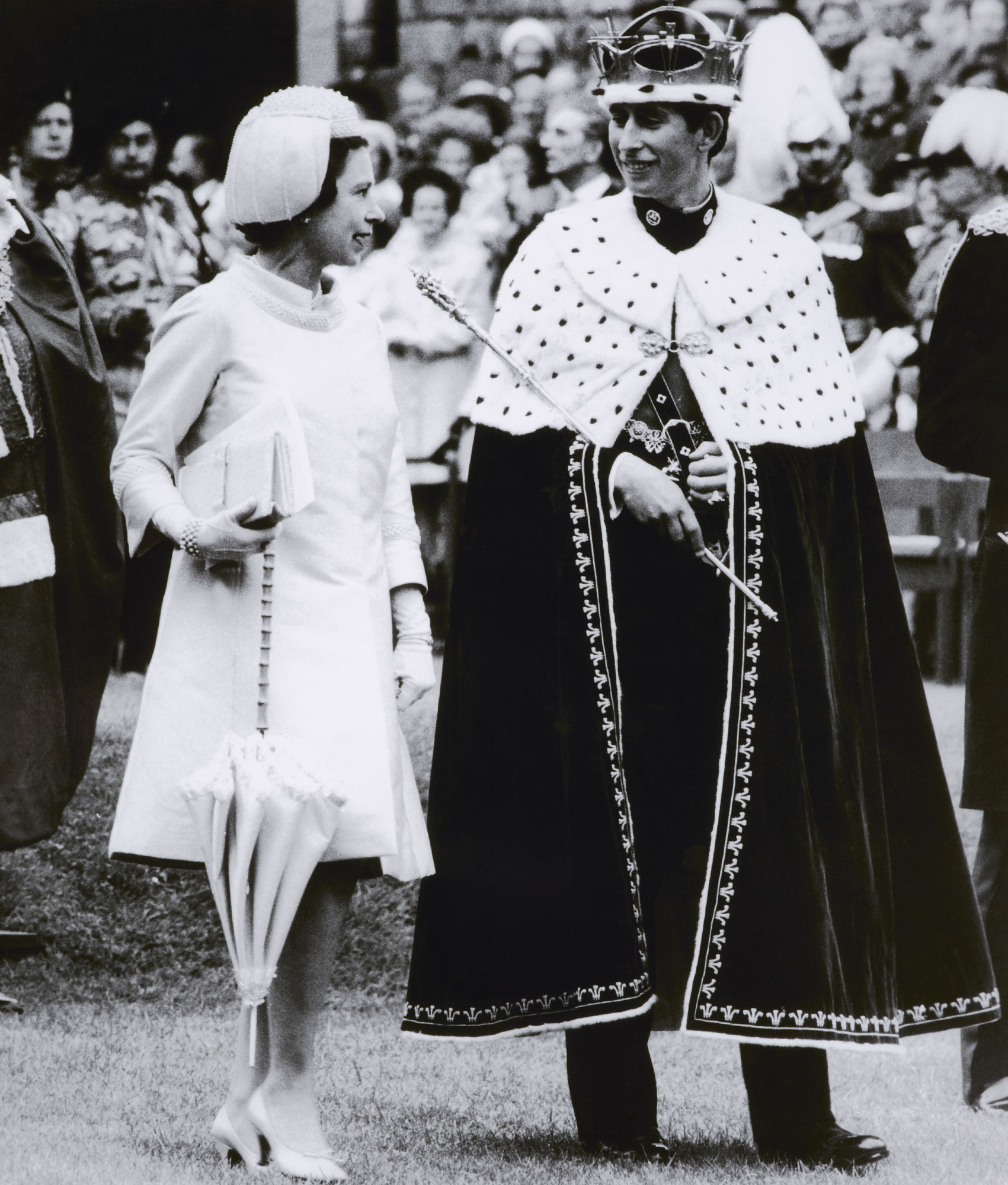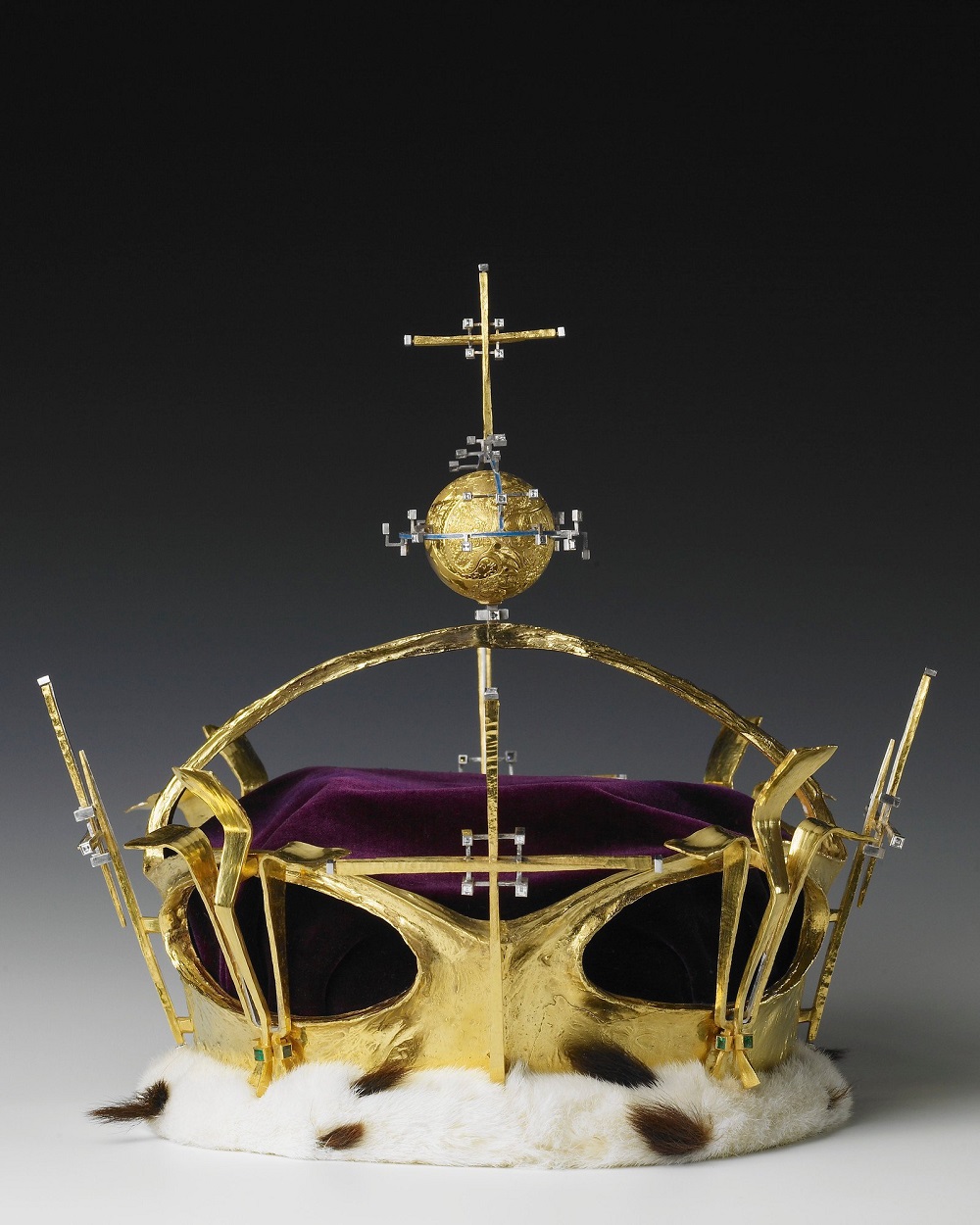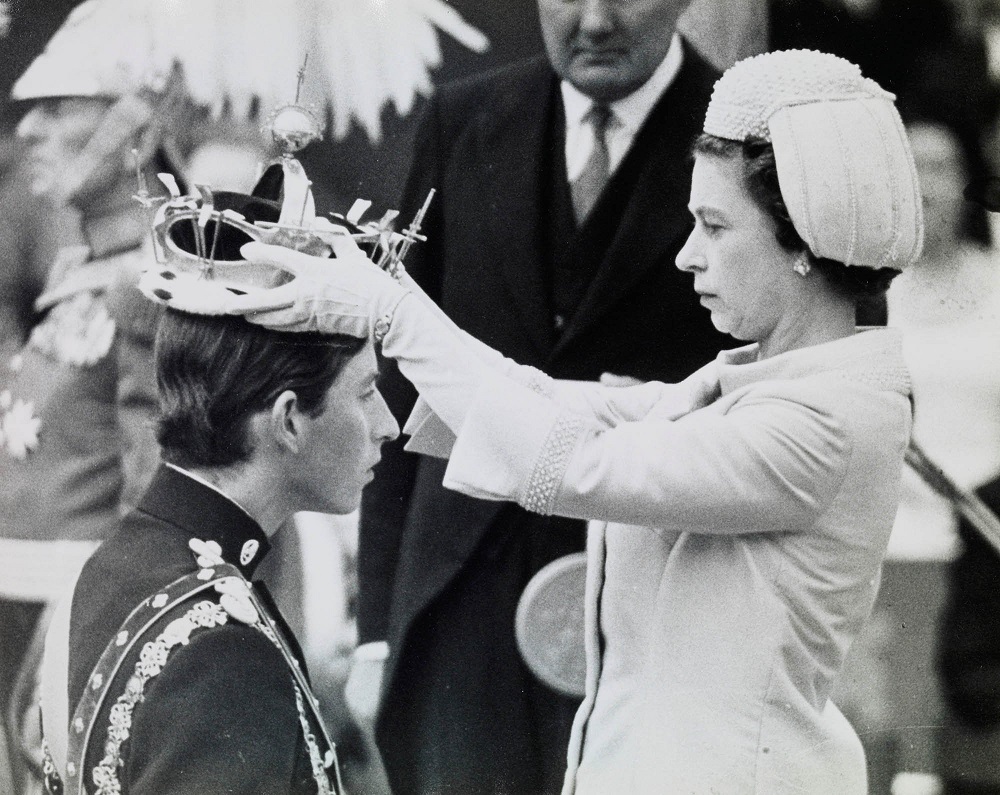King Charles III and The Gazette: Prince of Wales

Ahead of the coronation due to take place on Saturday 6 May 2023, historian Russell Malloch examines aspects of the new King’s life that have left a record in The Gazette. In this chapter, we look at the Welsh insignia of Charles III.
Chapters

Prince of Wales
The next step in the award of honours to Prince Charles took place on 26 July 1958 when letters patent were passed under the great seal of the United Kingdom to confer the dignities of prince of Wales and earl of Chester on the Queen’s son, who was already the duke of Cornwall and Rothesay (Gazette issue 41460).
The Gazette had reported the grant of the honours of Wales and Chester on a number of occasions, starting in September 1714 when the principality and earldom were given to the future King George II while he was still “the Electoral Prince of Brunswick-Lunenburgh, Duke of Cornwall and Rothsaye, Duke and Marquis of Cambridge, Earl of Milford Haven, and of Carrek, Viscount North Allerton, Baron of Tewkesbury and of Renfrew, Lord of the Isles, and Steward of Scotland” (Gazette issue 5264).
Prince Charles was only 9 years old when his patent was issued. There was no fixed pattern as to the age at which the titles were granted, and there was some variety in the family circumstances in which they were conferred. There was no notice about any patent for King James II’s son, but the Stuart heir was referred to in The Gazette as prince of Wales from a few days after his birth in June 1688 (Gazette issue 2361). Some older candidates followed, with the first Hanoverian patent being made out for the 31 year old German duke of Cambridge after his father came to England in 1714. The honours were then assigned to princes at ages ranging from a few days in August 1762 (George III) and December 1841 (Edward VII), through to 36 years in the case of Prince Charles’s great-grandfather (George V) in November 1901 (Gazette issue 27375).
Not all of Charles’s predecessors were prince of Wales before they succeeded to the Crown, as George I did not receive the Welsh dignity before he landed in England in 1714, and William IV held no more than the dukedom of Clarence when he succeeded his brother in 1830.
There was also the case of Prince Frederick who became prince of Wales in January 1729 (Gazette issue 6741) but died before his father, and so never gained the crown. And then Edward, who enjoyed the Welsh dignity between 1910 and his accession in 1936, but later abdicated and was still alive when his great-nephew became prince of Wales in 1958.
The Gazette reported several measures that were taken to strengthen Prince Charles’s connections with Wales, including the introduction of a distinctive flag, his investiture with princely regalia, and the creation of links with local regiments.
In May 1968 it was announced that the prince “shall fly and use in Wales upon all occasions a personal flag, quarterly or and gules four lions passant guardant counterchanged over all an inescucheon vert charged with the coronet of the Prince of Wales” (Gazette issue 44599).
This flag was based on a coat of arms that was attributed to Llewelyn ap Gruffydd, the 13th century ruler and last native prince of Wales, and followed a design that was introduced by an order in council in March 1911 when the shield representing the German duchy of Saxony, which appeared in the arms of the then prince of Wales, was replaced by the Welsh lions (Gazette issue 28473).
The new flag was hoisted for the first time at Cardiff on 11 June 1969, when Prince Charles attended the inauguration parade of the Royal Regiment of Wales.

Caernarvon investiture
A ceremony to invest Prince Charles with Welsh insignia was organised, and borrowed from the precedent of July 1911, when King George V went to Caernarvon Castle to present his 17 year old son – afterwards Duke of Windsor – with a coronet and other symbols that reflected his Welsh inheritance.
Prince Charles’s investiture took place at the same location in north-west Wales on 1 July 1969, when his 1958 patent was read by the home secretary James Callaghan, and the English text was rendered in the Welsh language by the secretary of state for Wales, George Thomas.
The patent referred to the prince being invested with a sword and coronet. This form of words seemed to belong to a different age, but in practice the text had been approved for use in documents relating to the grant of peerages as recently as the 1920s.
The Gazette reported the order in council of May 1927 that prescribed the form of a patent for the two senior degrees of duke and marquess, which stated that in each case the sovereign “dignified, invested and ennobled” the peer “by girding him with a sword and putting a cap of honour and a coronet of gold on his head and by giving into his hand a rod of gold” (Gazette issue 33274). The wording for the lower degrees of peer only required an earl to be given a sword, cap of honour and golden coronet, while the documents for barons and viscounts omitted all reference to insignia.
In practice, both before and after 1927, new peers were not girded with a sword, and did not receive a cap or rod, although all peers were able to wear coronets, which they usually only did during the coronation ritual.
Prince Charles’s patent adopted the usual wording for a peerage creation, but in contrast to the normal practice for senior peers (and in line with the 1911 precedent), the Queen invested her son with a sword, coronet and rod of gold, as well as placing a ring on his finger and robing him in a mantle of purple velvet.
The sword, ring and sceptre had been used at the Caernarvon ceremony in 1911, but the crown was of modern manufacture. The original coronet had gone into exile with the Duke of Windsor, and he was not required to return this royal treasure before his death in May 1972.
A new coronet was made by Louis Osman and presented by the Goldsmiths’ Company for use at the investiture (left). The unconventional design incorporated emblems that referred to Prince Charles rather than the Welsh dignity, with diamonds set to the pattern of the constellation Scorpio, which was the prince’s “star sign”, while other jewels represented what Osman described as “the seven deadly sins and the seven gifts of God under the domination of the finial cross”.
The investiture was marked by the issue of a special honours list, which was gazetted on 7 July 1969 (Gazette issue 44888). Awards included a knighthood for the chairman of the Wales Tourist Board, and the grand cross of the Victorian Order (GCVO) for the prince’s uncle, the Earl of Snowdon, who was the constable of Caernarvon Castle and responsible for organising part of the ceremony. The list brought promotion to the grade of commander in the Victorian Order (CVO) for the prince’s equerry David Checketts, and a DBE for Lady Olwen Carey-Evans, the daughter of prime minister David Lloyd George, who was noticed for her public service in Wales.
The event was commemorated by a medal that was produced by the Royal Mint. It was modelled by Michael Rizzello, who crafted the Welsh national memorial statute of David Lloyd George in Cardiff, and showed the prince’s portrait with the inscription Arwisgiad Charles Tywysog Cymru. Caernarfon 1969 (Investiture of Charles Prince of Wales Caernarvon 1969), and on the reverse the prince’s dragon badge with Y ddraig goch ddyry cychwyn (the red dragon leads the way).

Earl of Chester
No equivalent ceremony was held to invest Prince Charles with insignia for any of the peerages or titular dignities he received in 1952 when he became heir apparent, and no medals were struck to commemorate his dukedoms of Cornwall and Rothesay.
There was also no assembly at Chester Castle to confirm the grant of the earldom that was created at the same time as the Welsh dignity. This followed the practice in 1911, when a local member of Parliament proposed that Prince Edward should be invested as earl of Chester. His request was made while the coronation arrangements were still a work in progress, and the King’s secretary wrote:
“His Majesty fully appreciates the loyal wish of the people of Chester that such a ceremony should take place in their ancient and historic city, but on account of the exceptional demands upon their time during the coming summer it has been found necessary to abandon the projected visit to Chester.”
There were no major royal events in prospect that might have drawn resources from Cheshire in 1969, but there were other practical and financial considerations that worked against any elaborate ceremonial being organised along the lines of what had happened at Caernarvon.
Prince Charles visited Chester several times as earl, as in February 1971 when he toured the cathedral, attended a civic luncheon and received a pair of gold cufflinks bearing the city’s arms, which consisted of a blue shield with a sword and three garbs or bundles of wheat.
The English earldom was referred to in the Court Circular on a few occasions, as in July 2007 when the prince visited the Cheshire Military Museum and received an honorary doctorate of letters from the University of Chester, and in September 2014 when he and his wife visited the city and opened the Countess of Chester Country Park.
Northern Ireland
By the end of 1958 Prince Charles had gained titles in each of the old kingdoms of England and Scotland, as well as the principality of Wales, but he had nothing to reflect his family’s connection with Ireland.
There were precedents for Irish dignities being conferred on British princes. In 1849, for example, Albert Edward, prince of Wales (Edward VII) was made earl of Dublin at the age of 7 years (Gazette issue 21018), while in 1866 Queen Victoria’s son Alfred became earl of Ulster as well as duke of Edinburgh, and in 1892 George, Prince of Wales (George V), combined his dukedom of York with the title of baron Killarney, the town in County Kerry in what is now the republic of Ireland (Gazette issue 26291).
The Dublin and Killarney peerages merged in the Crown when their holders succeeded to the throne, and a few Irish titles were created for the sons of King George V. Prince Albert became baron Killarney and duke of York in 1920, while Prince Henry was made earl of Ulster at the same time as he received the dukedom of Gloucester in 1928, and Prince George became baron Downpatrick, in County Down in Northern Ireland, as well as duke of Kent in 1934.
The Irish dimension was reflected in the peerages Queen Elizabeth approved for her family, including the baronies of Killyleagh, Carrickfergus and Kilkeel in Counties Antrim and Down that were granted with the dukedoms of York in 1986, Cambridge in 2011 and Sussex in 2018. It was therefore notable that, despite the relevant precedents, Prince Charles received no title that connected him with the people of Northern Ireland.
The prince received no further honours relating to the House of Peers between 1958 and April 2021, when he became the second duke of Edinburgh, earl of Merioneth and baron Greenwich, the three dignities that were conferred on his late father in 1947. The Edinburgh, Merioneth and Greenwich peerages merged in the Crown in September 2022, and in March 2023 The Gazette explained that King Charles had directed that letters patent should be issued to confer a new dukedom of Edinburgh on his brother Edward, Earl of Wessex (Gazette issue 63995).

About the author
Russell Malloch is a member of the Orders and Medals Research Society and an authority on British honours.
See also
The Accession of King Charles III
Succession to the Crown: An introduction
Gazette Firsts: The history of The Gazette and royal coronations
Images
The Gazette
Royal Collection Trust / © His Majesty King Charles III 2023
Royal Collection Trust / © His Majesty King Charles III 2023
Royal Collection Trust / © His Majesty King Charles III 2023
Royal Collection Trust / © His Majesty King Charles III 2023
Publication date: 13 April 2023
Any opinion expressed in this article is that of the author and the author alone, and does not necessarily represent that of The Gazette.
